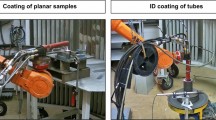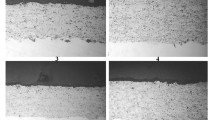Abstract
The filling powder, as a part of the feedstock in cored wires, directly influences the particle formation, in-flight particle behavior, the coating microstructure, and consequently the behavior of the desired coating, produced by twin wire arc spraying (TWAS). In this work, the effect of the particle size distribution of the filling powder in cored wires was studied. The process parameters were changed for different intervals of particle size distributions. Arc fluctuations were measured and found to be higher at smaller particle sizes. The in-flight particles showed a higher velocity when powders with smaller grain sizes were used and higher particle temperature when bigger grain sizes were used. The splats tended to form a regular disk shape in the case of smaller grain sizes. This investigation studied the important effect of using cored wires and the filling powders grain sizes on the TWAS process.


















Similar content being viewed by others
References
M. Pasandideh-Fard, “Droplet Impact and Solidification in a Thermal Spray Process,” Ph.D. Thesis, University of Toronto, 1998
J. Wilden, A. Wank, and F. Schreiber, Wires for Arc- and High Velocity Flame Spraying—Wire Design, Materials and Coatings Properties, Thermal Spray: Surface Engineering via Applied Research, C.C. Berndt, Ed., May 8-11, 2000 (Montréal, QC, Canada), ASM International, 2000, p 609-617
M. Nakagawa, K. Shimoda, T. Tomoda, M. Koyama, Y. Ishikawa, and T. Nakajima, Development of Mass Production Technology of Arc Spraying for Automotive Engine Aluminum Alloy Valve Lifters, Thermal Spray Research and Applications, T.F. Bernecki, Ed., May 20-25, 1990 (Long Beach, CA), ASM International, 1991, p 457-464
A. Pourmousa, A. Abedini, J. Mostaghimi, and S. Chandra, Particle Diagnostics in Wire-Arc Spraying System, Thermal Spray 2004: Advances in Technology and Application, May 10-12, 2004 (Osaka, Japan), ASM International, 2004, p 962-967
M.P. Planche, H. Liao, and C. Coddet, Relationships Between In-Flight Particle Characteristics and Coating Microstructure with a Twin Wire Arc Spray Process and Different Working Conditions, Surf. Coat. Technol., 2004, 182, p 215-226
G. Jandin, H. Liao, Z.Q. Feng, and C. Coddet, Correlations Between Operating Conditions, Microstructure and Mechanical Properties of Twin Wire Arc Sprayed Steel Coatings, Mater. Sci. Eng., 2003, A349(1-2), p 298-305
X. Wang, D. Zhuang, E. Pfender, J. Heberlein, and W. Gerberich, Effect of Atomizing Gas Pressure on Coating Properties in Wire Arc Spray, Thermal Spray Industrial Applications, C.C. Berndt and S. Sampath, Ed., June 20-24, 1994 (Boston, MA), ASM International, 1994, p 587-592
J. He, M. Ice, and E. Lavernia, Particle Melting Behavior During High-Velocity Oxygen Fuel Thermal Spraying, J. Therm. Spray Technol., 2001, 10(1), p 83-93
W. Tillmann, E. Vogli, M. Abdulgader, M. Gurris, D. Kuzmin, and S. Turek, Particle Behavior During the Arc Spraying Process with Cored Wires, J. Therm. Spray Technol., 2008, 17(5-6), p 966-973
H. Steffens, “Haftung und Schichtaufbau beim Lichtbogen- und Flammspritzen [Adhesion and Layer Structure in Arc and Flame Spraying],” Ph.D. Thesis, Technischen Hochschule Hannover, 1966
X. Wang, J. Heberlein, E. Pfender, and W. Gerberich, Effect of Nozzle Configuration, Gas Pressure, and Gas Type on Coating Properties in Wire Arc Spray, J. Therm. Spray Technol., 1999, 8(4), p 565-575
T. Watanabe, X. Wang, J. Heberlein, E. Pfender, and W. Herwig, Voltage and Current Fluctuations in Wire Are Spraying as Indications for Coating Properties, Thermal Spray: Practical Solutions for Engineering Problems, C.C. Berndt, Ed., Oct 7-11, 1996 (Cincinnati, OH), ASM International, 1996, p 577-583
T. Watanabe, T. Sato, and A. Nezu, Electrode Phenomena Investigation of Wire Arc Spraying for Preparation of Ti-Al Intermetallic Compounds, Thin Solid Films, 2002, 407, p 98-103
A.P. Newbery, T. Rayment, and P.S. Grant, A Particle Image Velocimetry Investigation of In-Flight and Deposition Behavior of Steel Droplets During Electric Arc Spray Forming, Mater. Sci. Eng., 2004, A383, p 137-145
A.P. Newbery, P.S. Grant, and R.A. Neiser, The Velocity and Temperature of Steel Droplets during Electric Arc Spraying, Surf. Coat. Technol., 2005, 195, p 91-101
S. Amada, H. Yamada, S. Yematsu, and Y. Saotome, Modelling and Measurements of Adhesive Strength on Thermal Sprayed Coatings, Thermal Spray: International Advances in Coatings Technology, C.C. Berndt, Ed., May 25-June 5, 1992 (Orlando, FL), ASM International, 1992, p 915-920
J.-Y. Fang, Z.-X. Li, J.-M. Jiang, and Y.-W. Shi, Difference in Particle Characteristics and Coating Properties Between Spraying Metallic and Ceramic Powder Cored Wires, Trans. Nonferr. Met. Soc. China, 2007, 17, p 537-542
M. Tuiprae, S. Wirojanupatump, and S. Jiansirisomboon, Characteristics of In-Flight Particles and Splats Thermally Sprayed by Using Conventional and Nano-Composite Cored Wires, Adv. Mater. Res., 2011, 160-162, p 1724-1731
A. Abedini, A. Pourmousa, S. Chandra, and J. Mostaghimi, Effect of Substrate Temperature on the Properties of Coatings and Splats Deposited by Wire Arc Spraying, Surf. Coat. Technol., 2006, 201, p 3350-3358
M. Pasandideh-Fard, V. Pershin, S. Chandra, and J. Mostaghimi, Splat Shapes in a Thermal Spray Coating Process: Simulations and Experiments, J. Therm. Spray Technol., 2002, 11(2), p 206-217
I.K. Hui, M. Hua, and H.C.W. Lau, A Parametric Investigation of Arc Spraying Process for Rapid Mould Making, Int. J. Adv. Manuf. Technol., 2003, 22, p 786-795
N.A. Hussary and J.V.R. Heberlein, Atomization and Particle-Jet Interactions in the Wire-Arc Spraying Process, J. Therm. Spray Technol., 2001, 10(4), p 604-610
Acknowledgments
The authors gratefully acknowledge the financial support of the Deutsche Forschungsgemeinschaft (DFG) within the collaborative research center SFB 708 TP/B3.
Author information
Authors and Affiliations
Corresponding author
Rights and permissions
About this article
Cite this article
Tillmann, W., Abdulgader, M. Particle Size Distribution of the Filling Powder in Cored Wires: Its Effect on Arc Behavior, In-Flight Particle Behavior, and Splat Formation. J Therm Spray Tech 21, 706–718 (2012). https://doi.org/10.1007/s11666-012-9769-7
Received:
Revised:
Published:
Issue Date:
DOI: https://doi.org/10.1007/s11666-012-9769-7




